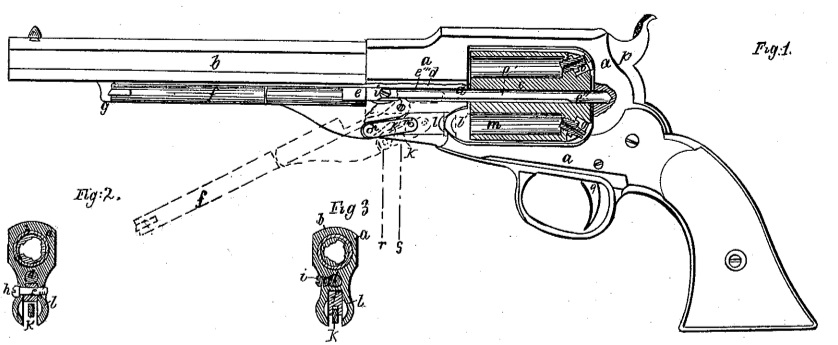US 37921
UNITED STATES PATENT OFFICE.
SAMUEL REMINGTON, OF ILION, NEW YORK.
IMPROVEMENT IN SECURING THE BASE-PINS OF REVOLVING FIRE-ARMS,
Specification forming part of Letters Patent No. 37,921, dated March 17, 1863.
To all whom it may concern:
Be it known that I, SAML. REMINGTON, of Ilion, in the county of Herkimer and State of New York, have invented a new and Improved Method of Holding the Base-Pins of Revolving Pistols; and I do hereby declare that the following is a full and exact description thereof, reference being had to the accompanying drawings, and to the letters of reference marked thereon.
Similar letters of reference indicate the same devices in all the figures. To enable others skilled in the art to comprehend, make, and use my invention, I will proceed to describe its nature, construction, and operation.
The nature of my invention consists in so constructing and arranging the base-pin and lever of revolvers in relation to each other that the lever shall prevent the base-pin from being drawn entirely out of the frame after it has been drawn sufficiently to liberate the cylinder.
Figure 1 is an elevation of my improved revolver, showing a portion of the frame broken away, so as to expose to view the base-pin, lever, link, and rammer; it also shows two positions of these devices. Fig. 2 is a section of my improved revolver at dotted lines. Fig. 3 is a section of the same at dotted line s.
a is the frame; b, band; c, cylinder; d, base pin; e, head of the same; e’, portion of the base-pin cut away; e’’, shoulder or rear extremity of said cut; f, lever; g, catch; h, joint of lever; i, set-screw; k, link; l, rammer; m, charge chamber; n and n’, joints of link connecting the lever and rammer; o, nipples; p, hammer; q, trigger; e’”, point of contact between the base-pin and joint h.
In those revolvers in which the base-pin and lever are so constructed and arranged that the base-pin cannot be drawn out in front without first moving the lever away from the barrel it becomes necessary, for greater security, to have some additional fastening for the base-pin besides that afforded by simply closing the lever down in front of it. When only one cylinder is used, as in the army, the base-pin often gets displaced during the process of ramming the charges. To prevent this accident I have employed set-screw i as an extra fastening for the base-pin, to be employed with base pins and levers which are constructed and arranged as above stated.
When duplicate cylinders are employed, which are loaded beforehand, an extra fastening is not required, as the cylinders are not loaded during action. The screw in that case may be partially withdrawn, so as not to press upon the base-pin, and left so. But in case only one cylinder is used the screw i should be turned down firmly upon the base pin, and should not be moved, except for the purpose of cleaning the arm. Thus by employing an extra fastening for the base-pin of my improved pistol single or duplicate cylinders may be used in it with equal facility and safety.
As a simple and secure means of preventing the base-pin from being lost out of the frame after it has been withdrawn sufficiently to liberate the cylinder, I have cut away the side of the base-pin, as seen at e’, and so arranged the lever in relation to the base-pin that in drawing the base-pin forward the knuckle or joint of the lever comes in contact with the shoulder e’’, formed by the cut e’, and so prevents the base-pin from being drawn out altogether. That portion of Fig. 1 which is drawn in red outlines represents these parts in the position which they occupy when the base-pin is prevented from being drawn entirely out of the frame by the joint h of the lever.
What I claim, and wish to have secured to me by Letters Patent, is–
So constructing the base-pin and arranging the joint of the lever in relation to the base-pin that said joint shall prevent the base-pin from being drawn entirely out of the frame, substantially as herein specified.
SAMUEL REMINGTON.
Witnesses:
H. M. STEVENS,
W. H. ELLIOT.

